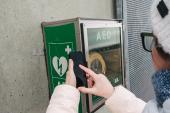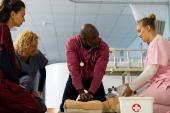In Taiwan, Convenience Stores an Ideal Spot for Public AEDs
Quantifying where there are gaps between need and supply could ultimately help bystanders act fast when cardiac arrest occurs.

Taking a geographic snapshot that compares where out-of-hospital arrests (OHCAs) occur versus where automatic external defibrillators (AEDs) are readily available to the public can provide valuable insights, according to a Taiwanese study.
In Taiwan, convenience stores appear to be the best locations for AEDs, investigators report in the Journal of the American Heart Association.
“Survival following an out-of-hospital cardiac arrest depends on prompt defibrillation. Despite the efforts made to install AEDs in crowded areas, their usage rate remains suboptimal,” researchers led by Chen-Bin Chen, MD (New Taipei Municipal TuCheng Hospital and Chang Gung University, New Taipei City, Taiwan), point out.
To address this gap, they envisioned a new metric—the coverage efficiency ratio, which captures how access to defibrillators currently matches up with where OHCAs occur as well as what the impact of adding new AEDs at various locations might be.
Importantly, “the effectiveness of adding [public-access defibrillators] should take into account people’s living habits,” senior author Cheng-Yu Chien, MD, PhD (New Taipei Municipal TuCheng Hospital and Chang Gung University), told TCTMD in an email. “In Asia, people are accustomed to using convenience stores to purchase daily necessities, so [these] stores are multifunctional and densely distributed. However, people in Europe and the United States have different habits.”
Prior studies have suggested other ideal spots for public AEDs: coffee shops and near bank automated teller machines in Toronto, for example, as well as mailboxes in southern England and telephone booths in Perth, Australia.
Douglas P. Zipes, MD (Indiana University School of Medicine, Indianapolis), commenting on the new data for TCTMD, agreed it makes sense that optimal AED locations would vary by country. One complicating factor, though, is that “in the United States we know that most cardiac arrests occur in a home. We've tried putting the AEDs in homes, and that really hasn't been terribly successful,” said Zipes.
The current study looking at OHCAs that happen in public—not at home—supports the notion that time is an essential element, he observed.
“The critical issue is how quickly you can get to someone with a defibrillator and defibrillate them,” Zipes said, adding, “It may be that a message is that individual countries need to establish where it is best to put their AEDs for rapid response.”
On top of access, though, there’s a need for bystanders who are capable and willing to use the AED.
Zipes noted that he’s long advocated that “AEDs should be as available as fire extinguishers and that we should be training youngsters in schools” as a way to “increase the pool of people who might be available to perform with an AED when someone goes down with cardiac arrest.”
Meeting People Where They Are
The Taiwanese investigators performed a retrospective cohort study, analyzing nontraumatic public OHCA cases that occurred in Taoyuan City between 2017 and 2021. Data were obtained from the local fire department as well as a regional registry; they excluded residential OHCAs and those that occurred in an institutional setting.
Taoyuan City has a bystander CPR rate of 59.7%, while the rate of public-access defibrillator usage is 8.2%. It contains 1,163 AEDs, of which 35% are located downtown and the rest elsewhere. During the study period, 1,407 public OHCAs occurred (36% of them downtown). The mean response time for emergency medical services was 443.7 seconds overall and on average was 64 seconds shorter downtown versus outside of town (P < 0.05).
Chien and colleagues identified all businesses and municipal locations with more than 20 branches in the city—including chain stores, libraries, schools, police and fire stations, mailboxes, clinics, pharmacies, bus stops, bike rental stations, and parking lots. Using geographic information system (GIS) software, they mapped out these locations and calculated the shortest “real-world walking route” between each OHCA case to all existing public-access defibrillators; if an OHCA occurred within a 100-meter walking distance of a defibrillator, it was considered covered.
Their analyses showed that existing public-access defibrillators only offered limited coverage for OHCAs. Both downtown and outside of downtown, bus stops and convenience stores emerged as locations that would offer better access to defibrillators.
Yet convenience stores appeared to be the best solution, said Chien. The coverage efficiency ratios indicated that “the establishment of [AEDs at] bus stations requires more resources and incurs higher costs,” he explained. “Compared to convenience stores, bus stations also face limitations in operating hours. Convenience stores, particularly in Asian countries, are often open 24 hours a day, so they are not subject to time restrictions.”
Chien agreed there is a human element and that simply making AEDs available won’t be enough to address OHCA. “The expansion of AEDs should be coordinated with education and training to ensure effectiveness. Currently, Taiwan’s Ministry of Health and Welfare regulations require units that install public-access defibrillators to appoint administrators for management and to conduct regular education and training,” he said.
As of now, there’s no government mandate for placing AEDs in convenience stores, which means that the stores would take on responsibility but not receive any economic benefits, Chien observed. “We plan to utilize corporate charity projects to persuade convenience stores to install public-access defibrillators and maintain education and training programs.”
The researchers also intend to investigate how improvements in access play out in the real world, given that “current efforts are based only on GIS analysis rather than actual data from OHCA patients,” he said.
Zipes, for his part, said that while lack of AEDs is a barrier, other things may be holding bystanders back. “The emotional impact of seeing someone in the throes of dying and responding to it is pretty intense, and I think that's one of the reasons why AEDs in homes have not been that successful: because it relies on presumably a loved one to resuscitate another loved one,” he said.
Creative approaches—like drone delivery of an AED—are fascinating, “but you still need people willing to use it and knowledgeable about how to use it,” Zipes concluded.
Caitlin E. Cox is News Editor of TCTMD and Associate Director, Editorial Content at the Cardiovascular Research Foundation. She produces the…
Read Full BioSources
Chen C-B, Wang M-F, Seak C-J. Installation of public access defibrillators for out-of-hospital cardiac arrests: identifying suitable locations by using a geographic information system. J Am Heart Assoc. 2024;13:e034045.
Disclosures
- The researchers and Zipes report no relevant conflicts of interest.





Comments